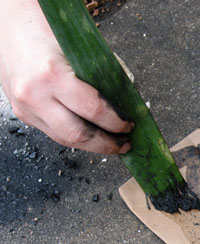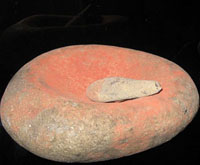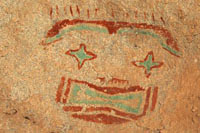
Yucca leaves, abundant in the desert, are easily shredded to create a handy paint brush. Photo by Susan Dial.  |
|
Native artists used pigments made from natural ingredients, chiefly minerals. Iron ores, hematite, and limonite produced red, yellow, and orange tones. Carbon, derived from charcoal, and manganese were used for black tones, and white clay and gypsum used for white. The more rare colors—such as green and blue—may have been derived from copper oxides or ground turquoise.
The pigments were ground to a powder using a grinding apparatus, either metate and mano, or in bedrock mortars and cupules, with a stone or pestle for grinding. To this powdered pigment was added a binder such as egg yolk, plant juice, animal fat, or even urine.
Paint was applied in a variety of imaginative ways: using brushes made from human hair, shredded yucca leaves, sticks, or with fingertips. Mineral or charcoal crayons also may have been used; researchers noted several locations where it appeared that a burning stick was used to create a charcoal drawing. In some pictographs, such as handprints, paint may have been blown through hollow bone or reeds to create "negative" impressions.
Some researchers believe some of the solid masks, with their crisp outlines, may have been created using a stencil. Former TPWD archeologist Ron Ralph recalls seeing built up paint around the edges of some of the solid masks that might have resulted from use of stencils. He suggests the artists may have applied a layer of mud or clay to a rock wall, then "carved" out the design while the mud was still wet. They likely would have allowed the design to dry before painting it. Alternatively, artists may have used dried animal hides in which they had cut out designs.
Archeologists also have documented hundreds of circular bedrock mortars and smaller cupules throughout the rocky hills, particularly at the base of ledges and inside rock shelters containing rock art. Whether these grinding features were used pulverizing pigment or for plant processing (or both) is not known. |

Minerals such as ocher were ground on a concave stone (metate) with a smaller hand stone (mano). Photo of display at the El Paso Museum of Archeology.  |

Red and orange colors could be made from hematite, but more exotic colors, such as green and blue, may derive from turquoise. Photograph by Rupestrian Cyberservice, courtesy of Texas Parks and Wildlife Department.  |
|